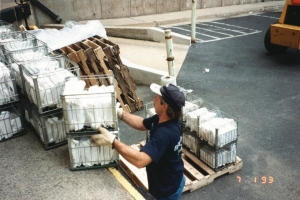Flood! The Pattee Library Water Emergency Recovery- June 25- July 22, 1993
Author: Sue Kellerman, Dec 2000

Damaged books
Summary of Events and Activities
The following is an account of the events that unfolded beginning on June 25, 1993, followed by statistics regarding the resulting recovery and salvaging activities. This water event was our first major collection emergency to affect the library since its opening in 1940.
DAY 1: June 25, 1993
3:00 a.m. - Penn State janitorial crew found water rushing into Stacks Level 2 of Central Pattee. A 12-inch water main pipe had erupted on Curtin Road (behind the library) with such force that asphalt and dirt had been spewed up from the road.
3:22 a.m. - PSU Police Services contacted library personnel and alerted them to the situation.
3:30 a.m. - Library personnel arrived at Pattee Library and discovered the building had received a rush of 890,000 gallons of water. Floodwater had seeped under a loading dock door in West Pattee, spread into the Literature Room and out into the stairwell between West and Central Pattee, and rushed into Stacks Level 2. Water had also collected in a window well along the north face of Central Pattee. The weight of the standing water caused the window to break, releasing hundreds of gallons of water into Stacks Level 2 and, from there, down the stairs into Stacks Level 1 Core.
What they found...
- 18 inches of standing water in Stacks Level 1Core. The bottom two shelves of books were completely submerged.
- 2-5 inches of standing water in Stacks Level 2.
- The elevator shaft in the Stacks was filling with water.
- In West Pattee, water was found dripping from ceiling tiles in the Reserve Reading Room and the Microforms Room.

Air drying books
4:02 a.m. - Library Facilities personnel and Library Stacks Maintenance staff arrived at Pattee Library.
6:30 a.m. - Personnel from Penn State’s Office of Physical Plant and Janitorial Services arrived to start cleanup. Four pumps were brought in to remove the standing water from Stacks Level 1 Core. Library personnel met to discuss recovery and salvage plans. Staff referred to disaster planning documents that were in the midst of being compiled to assist them with their recovery plans. Supplies and equipment were ordered for packing out materials. Arrangements were made with Penn State’s Housing and Food Services to use their freezers for receiving water-logged books. Penn State’s Office of Risk Management was contacted and a call was placed to the insurance company.
9:00 a.m. - Library Stacks Maintenance staff started to remove 65,000 at-risk volumes from the Literature Room. The books were dry but the carpeting was saturated. There was a real risk that mold might develop in the damp and warm conditions.
3:00 p.m. - Library staff (volunteers from all library departments) started to pack-out wet materials from Stacks Level 1 Core.
DAYS 2 & 3: June 26 and June 27, 1993
Eighty library staff (all library staff volunteers) worked upwards of 12 hour days to salvage the wet materials from Stacks Level 1 Core and Stacks Level 2. Damp materials were removed to one of four staging areas for air-drying. Volumes that were soaked (submerged) were wrapped, packed in milk crates and sent to the Penn State’s Housing and Food Services freezers for blast freezing.

Packed books are being sent to the freezers
DAYS 4-8: June 28 through July 1, 1993
Volunteers from the library staff worked to monitor the air-drying process. Staff from Cataloging’s Physical Processing unit cleaned mold from a small number of books. Books that were found to still be damp were packed out and sent to the freezers.
DAYS 9-21: July 2 through 22, 1993
A special clean-up crew of five full-time student employees was hired to review the air-dried books. Each book was assessed for condition. Some books were cleaned, others required remarking or rebinding; ones found in good condition were reshelved.
Flood Statistics:
- Total number of volumes affected: 30,600
- 17,100 volumes were air dried in-house;
- 12,100 volumes were sent for blast freezing and were eventually vacuum freeze-dried;
- 1,400 volumes (duplicates) were discarded;
- 49 reels of microfilm were replaced.
Recovery and Salvaging Statistics:
- All wet materials were stabilized within 48 hours;
- 156 library staff volunteered to assist in the recovery efforts (June 25 July 1, 1993);
- Pack-out rate was 50 books per hour per team (teams of four);
- Average vacuum freeze-drying cost was $6.70 per volume;
- 90% of all air dried volumes had been dried, reviewed, refurbished if needed and reshelved within a month of the flood (by July 22, 1993);
- 70% of all vacuum freeze-dried volumes had been reshelved within four months of the flood (by October 27, 1993);
- 30% of all salvaged volumes required rebinding;
- 49 reels of microfilm were replaced;
- 153 books were severely damaged and were replaced.